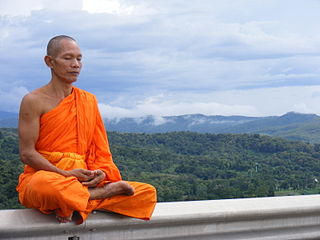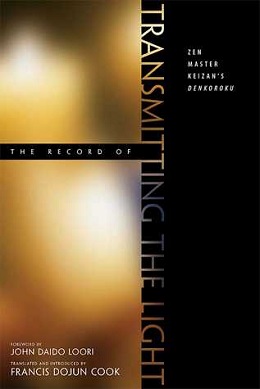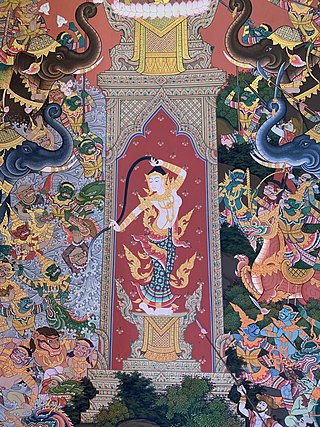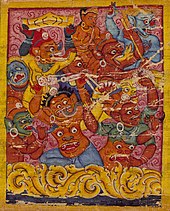Kenshō is an East Asian Buddhist term from the Chan / Zen tradition which means "seeing" or "perceiving" the "nature" or "essence". It is usually translated as "seeing one's (true) nature". The "nature" here refers to buddha-nature, ultimate reality, the Dharmadhatu. The term appears in one of the classic slogans which define Chan Buddhism: to see oneʼs own nature and accomplish Buddhahood (見性成佛).
Karuṇā is generally translated as compassion or mercy and sometimes as self-compassion or spiritual longing. It is a significant spiritual concept in the Indic religions of Hinduism, Buddhism, Sikhism, and Jainism.
Taṇhā is an important concept in Buddhism, referring to "thirst, desire, longing, greed", either physical or mental. It is typically translated as craving, and is of three types: kāma-taṇhā, bhava-taṇhā, and vibhava-taṇhā.
In the Buddhist tradition, the five hindrances are identified as mental factors that hinder progress in meditation and in daily life. In the Theravada tradition, these factors are identified specifically as obstacles to the jhānas within meditation practice. Within the Mahayana tradition, the five hindrances are identified as obstacles to samatha (tranquility) meditation. Contemporary Insight Meditation teachers identify the five hindrances as obstacles to mindfulness meditation.

In Buddhism, the Seven Factors of Awakening are:
Kleshas, in Buddhism, are mental states that cloud the mind and manifest in unwholesome actions. Kleshas include states of mind such as anxiety, fear, anger, jealousy, desire, depression, etc. Contemporary translators use a variety of English words to translate the term kleshas, such as: afflictions, defilements, destructive emotions, disturbing emotions, negative emotions, mind poisons, and neuroses.
Āyatana is a Buddhist term that has been translated as "sense base", "sense-media" or "sense sphere". In Buddhism, there are six internal sense bases and six external sense bases.
Sati, literally "memory" or "retention", commonly translated as mindfulness, "to remember to observe," is an essential part of Buddhist practice. It has the related meanings of calling to mind the wholesome dhammas such as the four establishments of mindfulness, the five faculties, the five powers, the seven awakening-factors, the Noble Eightfold Path, and the attainment of insight, and the actual practice of maintaining a lucid awareness of the dhammas of bodily and mental phenomena, in order to counter the arising of unwholesome states, and to develop wholesome states. It is the first factor of the Seven Factors of Enlightenment. "Correct" or "right" mindfulness is the seventh element of the Noble Eightfold Path.

The Sutta Nipāta is a Buddhist scripture, a sutta collection in the Khuddaka Nikaya, part of the Sutta Pitaka of the Pali Canon of Theravada Buddhism. Sutta Nipata is a collection of discourses of Buddha. It is part of an early corpus of Buddhist literature. Chalmers explains that sutta means a consecutive thread of teaching and Oldenberg explained that nipata denotes a small collection.
Jarāmaraṇa is Sanskrit and Pāli for "old age" and "death". In Buddhism, jaramarana is associated with the inevitable decay and death-related suffering of all beings prior to their rebirth within saṃsāra.

The Dhammacakkappavattana Sutta is a Buddhist scripture that is considered by Buddhists to be a record of the first sermon given by Gautama Buddha, the Sermon in the Deer Park at Sarnath. The main topic of this sutta is the Four Noble Truths, which refer to and express the basic orientation of Buddhism in a formulaic expression. This sutta also refers to the Buddhist concepts of the Middle Way, impermanence, and dependent origination.

Bodhi Day is the Buddhist holiday that commemorates the day that Gautama Buddha (Shakyamuni) is said to have attained enlightenment, also known as bodhi in Sanskrit and Pali. According to tradition, Siddhartha had recently forsaken years of extreme ascetic practices and resolved to sit under a peepal tree, also known as a Bodhi tree, and simply meditate until he found the root of suffering, and how to liberate oneself from it.

Abhijñā is a Buddhist term generally translated as "direct knowledge", "higher knowledge" or "supernormal knowledge." In Buddhism, such special knowledge is obtained through virtuous living and meditation. The attainment of the four jhanas, or meditative absorptions, is considered a prerequisite for their attainment. In terms of specifically enumerated knowledges, these include mundane extra-sensory abilities as well as the supramundane, meaning the extinction of all mental intoxicants (āsava).
In Buddhism, a mental fetter, chain or bond shackles a sentient being to saṃsāra, the cycle of lives with dukkha. By cutting through all fetters, one attains nibbāna.

Denkōroku is a kōan collection written in 1300 by Keizan Jokin Zenji, the Great Patriarch of Sōtō Zen Buddhism, based on approximately a year of his Dharma talks.

The Ādittapariyāya Sutta, is a discourse from the Pali Canon, popularly known as the Fire Sermon. In this discourse, the Buddha preaches about achieving liberation from suffering through detachment from the five senses and mind.
In Buddhism, the bodhipakkhiyā dhammā are qualities conducive or related to awakening/understanding, i.e. the factors and wholesome qualities which are developed when the mind is trained.
Iddhipāda is a compound term composed of "power" or "potency" and "base," "basis" or "constituent" (pāda). In Buddhism, the "power" referred to by this compound term is a group of spiritual powers. Thus, this compound term is usually translated along the lines of "base of power" or "base of spiritual power." In the Buddhist pursuit of bodhi and liberation, the associated spiritual powers are secondary to the four "base" mental qualities that achieve such powers. These four base mental qualities are: concentration on intention; concentration on effort; concentration on consciousness; and, concentration on investigation. These four base mental qualities are used to develop wholesome mental states and rid oneself of unwholesome mental states.

Vasundharā or Dharaṇī is a chthonic goddess from Buddhist mythology of Theravada in Southeast Asia. Similar earth deities include Pṛthivī, Kṣiti, and Dharaṇī, Vasudhara bodhisattva in Vajrayana and Bhoomi devi and Prithvi in hinduism.
MĀRA: A Chamber Opera on Good and Evil is an American chamber opera in two acts composed by Sherry Woods to a libretto by Stephen Batchelor. The opera humanizes the story of Siddhattha Gotama and his encounters with Māra, Taṇhā, and the demonic figures that appear to him as he seeks a way to live an awakened life in the world.











